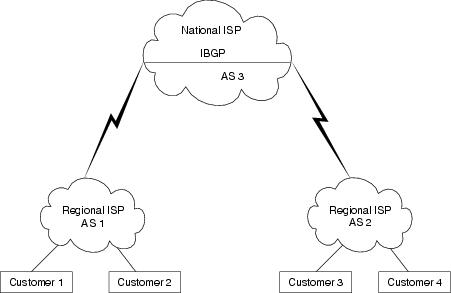Introduction
The Border Gateway Protocol (BGP) is an interautonomous system routing protocol. An autonomous system is a network or group of networks under a common administration and with common routing policies. BGP is used to exchange routing information for the Internet and is the protocol used between Internet service providers (ISP). Customer networks, such as universities and corporations, usually employ an Interior Gateway Protocol (IGP) such as RIP or OSPF for the exchange of routing information within their networks. Customers connect to ISPs, and ISPs use BGP to exchange customer and ISP routes. When BGP is used between autonomous systems (AS), the protocol is referred to as External BGP (EBGP). If a service provider is using BGP to exchange routes within an AS, then the protocol is referred to as Interior BGP (IBGP). Figure 39-1 illustrates this distinction.
Figure 39-1 External and Interior BGP

BGP is a very robust and scalable routing protocol, as evidenced by the fact that BGP is the routing protocol employed on the Internet. At the time of this writing, the Internet BGP routing tables number more than 90,000 routes. To achieve scalability at this level, BGP uses many route parameters, called attributes, to define routing policies and maintain a stable routing environment.
In addition to BGP attributes, classless interdomain routing (CIDR) is used by BGP to reduce the size of the Internet routing tables. For example, assume that an ISP owns the IP address block 195.10.x.x from the traditional Class C address space. This block consists of 256 Class C address blocks, 195.10.0.x through 195.10.255.x. Assume that the ISP assigns a Class C block to each of its customers. Without CIDR, the ISP would advertise 256 Class C address blocks to its BGP peers. With CIDR, BGP can supernet the address space and advertise one block, 195.10.x.x. This block is the same size as a traditional Class B address block. The class distinctions are rendered obsolete by CIDR, allowing a significant reduction in the BGP routing tables.
BGP neighbors exchange full routing information when the TCP connection between neighbors is first established. When changes to the routing table are detected, the BGP routers send to their neighbors only those routes that have changed. BGP routers do not send periodic routing updates, and BGP routing updates advertise only the optimal path to a destination network.
1 Comment:
need to add more information.
Post a Comment